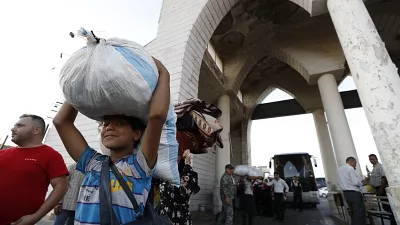
Families fleeing the escalating conflict in Lebanon poured into Syria in growing numbers on Wednesday, waiting for hours in heavy traffic to reach the relative safety of another war-torn country.
U.N. officials estimated that thousands of Lebanese and Syrian families had already made the journey, and those numbers are expected to grow as Israel targets southern and eastern Lebanon in an aerial bombardment.
Local officials say the strikes have killed more than 600 people this week. Israel says it is targeting Hezbollah fighters and weapons, but roughly a quarter of the killed have been women and children.
Lines of buses and cars extended for several miles from the Syria border beginning Monday, and some families were seen making the journey on foot.
Once in Syria, people waited hours more to be processed by overwhelmed border officials, and relief workers handed out food, water, mattresses and blankets.
In the Syrian border town of Jdeidet Yabous, some families sat glumly on the side of the road when Associated Press journalists visited the area.
Some used their bags as seats, waiting for taxis, buses or relatives to pick them up. Many said they had spent eight or nine hours in traffic just to get into Syria.
Before crossing into Syria, crowds packed into a government office to be processed by immigration officers and – in the case of Syrian citizens, to change $100 to Syrian pounds as they enter the country — a measure imposed in an attempt to prop up the local currency by bringing more dollars into the country.
Due to the sudden spike in demand, the supply of Syrian pounds at the border ran short.
Some were returning Syrian refugees, like Ahmed al-Halabi, who fled to Lebanon in 2014.
“We went to south Lebanon and lived and worked there. Then this latest war in the south started, there were too many strikes and there was a lot of destruction, so we left the south because of the strikes. We barely made it, we’ve been on the road for three days,” he said.
Many Lebanese families were also fleeing. Hussein al-Abdullah, who lives in Baalbek in the Bekaa Valley, one of the areas heavily targeted by Israeli bombardment.
The cross-border flow was a striking reversal in fortunes given that Lebanon is still hosting more than one million Syrian refugees who fled the war in their country that began in 2011.
That’s when an initially peaceful anti-government uprising was met by a brutal government crackdown and spiraled into an ongoing civil war.
Some 775,000 Syrians are registered with the U.N. Refugee Agency in Lebanon, and hundreds of thousands more are believed to be unregistered in the country.
For many in Lebanon, particularly those living in the Bekaa Valley in the east, Syria appeared to be the quickest route to safety.
While the war in Syria is ongoing, active fighting has long been frozen in much of the country. Lebanese citizens, who can cross the border without a visa, regularly visit Damascus and renting an apartment is significantly cheaper in Syria than in Lebanon.
Even before the latest escalation, some Lebanese had rented in Syria as a Plan B in case they needed to flee.
Apart from those who fled the war, many Syrians come to Lebanon for work or family reasons, and regularly cross the border.
However, many of those who came as refugees have been reluctant to return out of fear they could be arrested for real for perceived ties to the opposition to Syrian President Bashar Assad, or forcibly conscripted to the army. If they leave Lebanon they could also lose their refugee status.
Earlier this week, Assad issued an amnesty for crimes committed before Sept. 22, including those who dodged compulsory military service.
He had issued similar amnesties over the past years, but they largely failed to convince refugees to return, as have efforts by Lebanese authorities to organize “voluntary return” trips.


